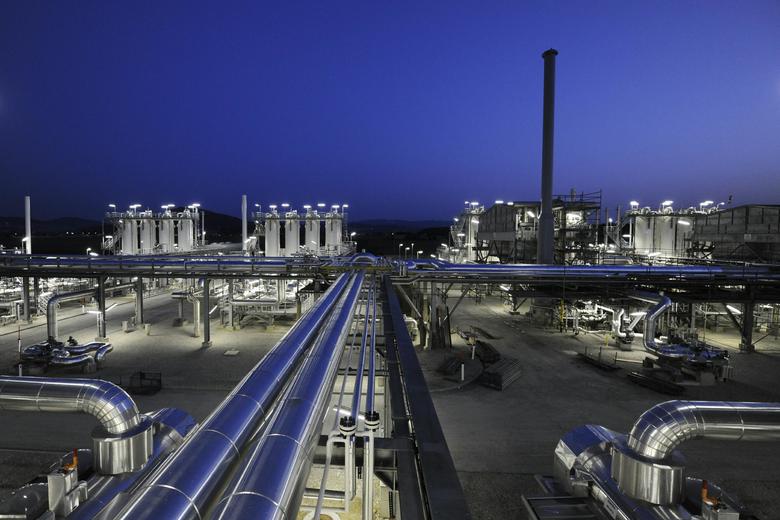
EUROPE: MORE LNG

In 2015, natural gas prices declined as the result of an oversupply made worse by the falling cost of coal, rising use of renewables, better energy efficiency and the warmest year on record. The result: benchmark contracts had their first consecutive annual loss, ending the year at their lowest levels since 2009.
Now, amid a drop in Asian demand, Europe is becoming a more likely target destination for natural gas as the US prepares to ship its first tankers of liquefied fuel from the shale boom, Australia expands its exports, forcing Middle Eastern suppliers to seek new customers, and Russia fights to maintain market share.
"With Europe increasingly becoming the dumping ground for the world's surplus LNG, 2016 should see a continuation of the oversupply situation in European gas markets," said Alan Whitefield, managing director of AW Energy Solutions, a gas and LNG consultant in London. "An unseasonably mild winter can only exacerbate this situation if we head into spring with ample storage stocks."
Here are the biggest questions facing the European market.
1. How much gas will the EU produce?
Europe's largest gas field in the Dutch province of Groningen faces production restrictions after extraction was linked to earthquakes in the region. The government said Groningen can produce only 27 billion cubic meters (950 billion cubic feet) of gas in the 12 months through September. Only if it's cold can the cap go up to the prior limit of 33 billion.
The cuts have already pushed the Netherlands into becoming a net importer of gas despite being the European Union's largest onshore producer. Dutch gas buyers Germany, France and Belgium are also in the process of adjusting their networks to replace Groningen supply by 2030.
Meanwhile, the UK has said it wants to move forward in exploring its shale gas resources, potentially adding to European supply, as the depletion of North Sea fields caused its gas output to drop 62% in 2014 from a decade earlier. Next year production companies may drill some of the first exploratory wells to assess the country's deposits.
2. Will Europe see more LNG arrivals?
European LNG deliveries are rising as new plants in Australia boost supply to Asia amid declining demand, causing some cargoes from the Middle East to divert to northwest Europe, the only region outside North America with a sufficient amount of gas trading to absorb the excess.
Import terminals in the UK, Belgium and the Netherlands are set to get 167 cargoes this year, up from 132 in 2014 and the most since 2011, according to port and ship-tracking data compiled by Bloomberg. The restart of reactors halted since the Fukushima nuclear disaster in 2011, lower industrial growth and increasing renewable generation are reducing consumption of gas in Japan, the world's biggest LNG buyer, leaving more cargoes available for Europe.
Next year, Europe's net LNG imports will probably gain 22% to 45 billion cubic meters, according to Societe Generale.
3. Will US gas come to Europe?
Europe, with its accessible trading hubs and underused import infrastructure, may lure US LNG, which has no restrictions on destination and would have to compete with pipeline supplies from Russia and Norway.
"Given the volumes of gas shipped to Europe, the marginal cost of additional Russian gas is low and they should be able to compete with US LNG supplies," said Malcolm Johnson, a Guildford, England-based faculty member of The Oxford Princeton Programme, an energy training provider. "However, it is clear that in certain countries there is a desire to diversify supplies for supply security."
That desire to diversify away from Russian dependence has motivated countries such as Lithuania to sign supply agreements with US exporters including Cheniere Energy. US LNG will probably be able to compete on European hubs this winter, Bloomberg New Energy Finance said earlier this month.
4. How much Russian gas will Europe get?
Gazprom plans to keep gas supplies to Europe at about 156 billion to 160 billion cubic meters (5.5 trillion to 5.6 trillion cubic feet) a year in 2016-18, according to Sergei Komlev, head of pricing and contract structuring at the Moscow-based producer's export arm. The piped gas export monopoly also has guaranteed sales in Europe due to contract terms that oblige buyers to take agreed minimum volumes each year.
Russian gas meets about a third of the region's demand, is cheap to produce and linked to oil prices that crashed 34% this year, with recent declines set to filter into long- term contracts next year thanks to a six- to nine-month time lag. Imports from Russia increased in 2015 as the fuel became competitive against gas on hubs.
Meanwhile, Gazprom is battling EU accusations that it charged Poland and the Baltic States as much as 21% more than the average, with regulators stepping up efforts to cut the bloc's dependence on Russia. More LNG making its way to Europe will probably also start squeezing out some Russian gas, according to Energy Aspects, a London-based consultant that sees imports from Gazprom decreasing 4% next year.
5. Can storage still dictate prices in Europe?
If you wanted to make money in gas storage in the EU, 2015 wasn't your year.
"Those who invested in gas storage or gas-fired power have all burned their fingers, if not their entire arm," Frank van Doorn, head of gas trading at Vattenfall Energy Trading, said at a conference in September.
Storage levels are at their highest for the time of year since at least 2009, according to data from Gas Infrastructure Europe, because no one takes gas from the facilities if it's warm and flows directly from suppliers are cheap. Full storage sites reduce volatility, hurting those who profit from buying gas at a low price and selling it high.
-----
More:
NORD STREAM - 2: A SHOT IN THE FOOT

